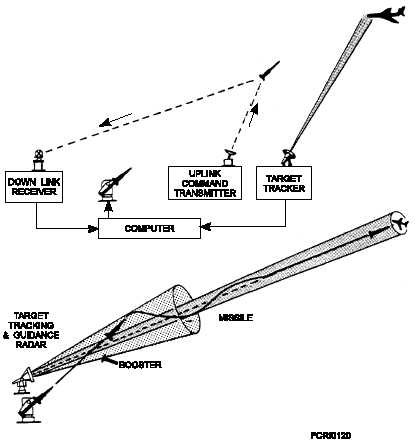target (fig. 1-21, view A). The RF energy strikes the
target and is reflected back to the missile.
(This
process is referred to as “illuminating the target.”) The
missile seeker (receiving) antenna detects the reflected
energy and provides it as an input to the missile
guidance system. The guidance system processes the
input, usually called the homing error signal, and
develops target tracking and missile control
information. Missile control causes the missile to fly a
desired flight path.
The effective range of the missile transmitter is
somewhat limited because of its size (power output).
For this reason, relatively long-range missiles, such as
HARPOON, do not switch to active guidance until
after midcourse guidance has positioned the missile so
that the transmitter is within its effective range.
Semiactive Homing.—In a semiactive homing
system, the target is illuminated by a transmitter (an
illuminator) on the launching site (fig. 1-21, view B).
As with active homing, the transmitted RF is reflected
by the target and picked up by the missile’s receiver.
The fact that the transmitter’s size is not limited, as
with active homing, allows a much greater range.
The missile, throughout its flight, is between the
target and the radar that illuminates the target. It will
receive radiation from the launching ship, as well as
reflections from the target. The missile must therefore
have some means of distinguishing between the two
signals, so that it can home on the target rather than on
the launching ship. This can be done in several ways.
For example, a highly directional antenna may be
mounted in the nose of the missile; or the Doppler
principle may be used to distinguish between the
transmitter signal and the target echoes. Since the
missile is receding from the transmitter and
approaching the target, the echo signals will be of a
higher frequency. Most SMS missiles use both of these
methods.
A drawback of this system is that the shipboard
illumination is not free to engage another target while
the missile is in flight. STANDARD SM-1 and SEA-
SPARROW all use semi-active homing as their
primary guidance; they do not use midcourse
guidance.
The STANDARD SM-2 uses midcourse
guidance, and then semi-active homing only for
terminal guidance.
As a result, the SM-2 needs
illumination from the ship only for the last few seconds
of flight.
1-17
A.
B.
Figure 1-20.—Simplified command guidance systems: A. Radar/radio command; B. Beam rider.


